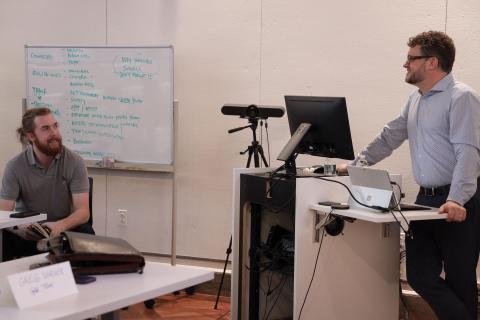A deep dive into exhibition planning and project management was presented by Steve Mann, head of exhibitions for the National Gallery of Art, to nearly two dozen students at GW’s Corcoran School of the Arts and Design. The workshop was one of a series taught by experts from the National Gallery as part of a new programmatic partnership with the Corcoran School, housed in the Columbian College of Arts and Sciences.
The workshop series was organized by Babette Pendleton, exhibition and programming associate for the Corcoran School. Other workshops this semester will focus on exhibition writing, sound and audiovisual aspects of exhibition, curatorial strategies and website design, to name just some of the topics on tap.
After a brief discussion of his professional trajectory, Mann gave students an in-depth look at the kinds of things he does in his current job at the National Gallery.
“Working in museums,” he advised those planning to go into the profession, “you’re often in a state of renovation or construction.”
One of his more memorable duties in a previous job as a studio manager for the contemporary photographer and installation artist Sandy Skoglund, he said, was gluing jellybeans together while making sure that no two candies of the same color touched.
“Many exhibits that museums organize go to other museums as well,” Mann said, and those other museums may figure into exhibition planning. And while many museums rely on ticket sales, he noted, the National Gallery (like Mann’s previous employer, the Baltimore Museum of Art) does not, allowing both institutions to emerge from the COVID pandemic in good financial condition.
At the National Gallery, Mann heads a team of 10 people. In addition to himself and an assistant, there are four project managers, three assistant project managers, and one person to run the software.
The rise of project managers as a profession, he said, reflects the museum field’s interest in working with living artists. He talked about the importance of working with artists who are able to work cooperatively with museum staff—for example, completing their works in time to allow others to play their necessary role.
At a basic level, Mann said, he and colleagues ask each other the question, What is an exhibition? The definition he settled on is that an exhibition is “a curated presentation of artwork on a specific topic that is on view for a limited time,” which may be organized around a time, place, theme or social issue.
One of the most successful thematic shows he worked on was “Guarding the Art,” co-curated by 17 security guards at the Baltimore Museum of Art. Visitors to the popular exhibition regarded the artworks, chosen by everyday people, as very accessible.
Quickly noting the various types of artworks, he listed paintings, sculpture, works on paper, time-based media and textiles.
“Works on paper and textiles in particular are very light-sensitive,” he said, meaning that different considerations come into play when working with those materials.
Mann also spoke of the special nature of exhibition planning, which might mean working far in advance of a show to secure loans of artworks from private collectors or other institutions.
“Imagine asking someone if you can borrow their car in five years,” he said.
Restoration and conservation are also issues that emerge in exhibition planning. Many European churches and other institutions, he noted, own Renaissance masterpieces but lack resources to restore them, so they loan objects strategically.
Reliable advance measurements of artworks scheduled for showing are important for a successful exhibition, he said.
Some of the many other questions Mann addressed include: Where do exhibition ideas come from? What are some curatorial considerations in planning an exhibition? What are some of the skills needed for effective program management?
To the latter question, his answers included the ability to do advance planning; to run meetings and be comfortable speaking in public (“That just takes practice,” he said); being comfortable playing a leadership role (being direct and holding people accountable); math and accounting knowledge; and legal knowledge to be able to negotiate contracts.
“Project management is about having an entire plan in place when you start, not just addressing needs as you go,” Mann said. “A digital project management system can help remind people about their timelines and deadlines.”







